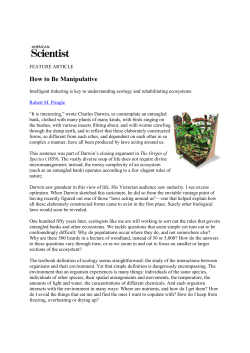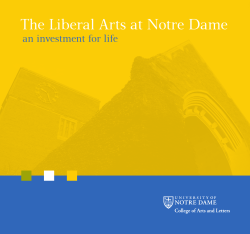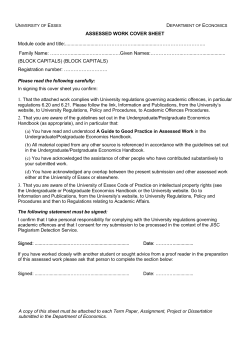
ECONOMY AS ECOSYSTEMS
KNOWLEDGE MANAGEMENT, ORGANIZATIONAL INTELLIGENCE AND LEARNING, AND COMPLEXITY - Vol. III Economy as Ecosystems - D.Z. Sui ECONOMY AS ECOSYSTEMS D.Z. Sui Department of Geography, Texas A&M University, USA Keywords: evolutionary economics, ecological economics, industrial ecology, coevolution Contents U SA NE M SC PL O E – C EO H AP LS TE S R S 1. Introduction 2. Mechanistic versus Biological Metaphors in Economics 3. Ecology as Nature’s Economy 4. Economy as Ecosystems 5. Putting the Idea into Practice: Ecological Economics and Industrial Ecology 6. Perils of Stepping over the Line: Social Darwinism and Socio-biology 7. Conclusion: Towards a Green Future by Co-Evolution Glossary Bibliography Biographical Sketch Summary This article first reviews the role of biological versus mechanistic metaphors in facilitating the understanding of economy. It then traces the development of ecology conceived as nature’s economy, followed by discussions on how our knowledge of ecosystems can help us to gain a better understanding of the economy and with the development of better economic business strategies. By tying to the recent developments in ecological economics and industrial ecology, this paper calls for a fundamental paradigm shift from viewing economy as ecosystems for profit, to conceptualizing economy for ecosystems with the goal of achieving sustainability. Specific practices espoused by ecological economics and industrial ecology are reviewed, followed by a cautionary note on the perils of overstretching the biological metaphor in social affairs. This article ends by advocating a co-evolutionary manifesto with the credo “live and let live” in order to sustain the frail life-support system on the planet earth for the long haul. 1. Introduction The development of economic thought is littered with various metaphors and analogies that have greatly facilitated the understanding (and sometimes misunderstanding) of how economy works. These metaphors and analogies have given life to many dreary subject matters, otherwise widely known as the domain of the dismal science of economics. These metaphors and analogies are essentially of two kinds: physical and biological. This article will focus on the role of biological metaphors and analogies in the understanding of economy. Specifically, it will discuss what we have learned, both in theory and practice, by reconceptualizing the economy as ecosystems to economy for ecosystems. ©Encyclopedia of Life Support Systems (EOLSS) KNOWLEDGE MANAGEMENT, ORGANIZATIONAL INTELLIGENCE AND LEARNING, AND COMPLEXITY - Vol. III Economy as Ecosystems - D.Z. Sui This article is organized into seven sections. After a brief introduction, section two gives an overview of mechanistic and biological metaphors in economic thought. Section three reviews the development of ecology conceptualized as nature’s economy. Section four discusses the theoretical and practical implications of conceptualizing economy as ecosystems, followed by an introduction on how to put the idea into practice for sustainable development in ecological economics and industrial ecology. Section six discusses the perils of overstretching the biological metaphor as exhibited in social Darwinism and socio-biology. The last section addresses issues related to sustainable development. This ends by advocating a co-evolutionary paradigm towards a green future. 2. Mechanistic versus Biological Metaphors in Economics U SA NE M SC PL O E – C EO H AP LS TE S R S Human thinking and cognitive abilities are inherently metaphorical, and scholars have paid increasing attention to the role of metaphors in economic theories and models. Generally speaking, most models developed in economics are based upon either a physical/mechanistic metaphor or a biological/ecological metaphor. The root metaphor in neo-classic economics focusing on equilibrium (decreasing returns) is a mechanistic one, and the concept of evolutionary economics is motivated by a biological metaphor, which concentrates on disequilibrium (increasing returns). The mechanistic metaphor embedded in classic economics has a built-in deterministic and ahistorical ontology. Inspired by a mechanistic metaphor, the economy is conceptualized more or less like a gigantic machine, composed of parts, and economics is the study of the interaction of those parts. Here, aspects of human life are determined and represented by the calculus of variation, and human agents have no choice but to behave in accordance with physical laws such as the laws of least effort or maximum profit. Such a worldview is also ahistorical: reality is theorized in logical time, not historical time. Motion is completely reversible and gives rise to no qualitative changes. The epistemology behind a mechanistic metaphor is based upon the Cartesian separation of object and subject and thus is inherently reductionistic. The social physics according to the Newtonian mechanistic metaphor always reduces the complexity of the real world to elemental components in order to facilitate analytical treatment. Implicit in the various propositions in classic and neo-classic economics, the centrality of rational individuals is assumed and human irrationalities are not considered. The mechanistic metaphor also imposes a strong sense of teleology on the system we model. The purpose of the system is to optimize or maximize everybody’s objective function. In fact, the meaning of life has been reduced to maximize certain utility functions according to the mechanistic worldview. Despite its analytical elegance and contributions to the development of neoclassic economic theories, more and more economists and non-economists alike have realized that neoclassic economics according to a Newtonian mechanistic metaphor only present us a very partial, limited view of reality. In most cases, they have generated more heat than light in our quest to understand the world and the conclusions reflect more the internal logic of the mechanistic metaphor rather than the phenomenon itself to be modeled. ©Encyclopedia of Life Support Systems (EOLSS) KNOWLEDGE MANAGEMENT, ORGANIZATIONAL INTELLIGENCE AND LEARNING, AND COMPLEXITY - Vol. III Economy as Ecosystems - D.Z. Sui U SA NE M SC PL O E – C EO H AP LS TE S R S The development of evolutionary economics was motivated by a biological metaphor in general, and evolutionary thinking in particular. Its ontology rejects the Laplacian dream of full mathematical determinacy. Instead, the world is assumed to be a result of the interplay between chance and necessity. The simultaneous randomness and determinacy accentuate historical process and irreversible change. Reality is not only path-dependent but also non-linear in its dynamics -- small changes can provoke wider reverberations throughout the entire system. Its epistemology denies the understanding of the whole by analyzing its parts. Instead of viewing the world as a gigantic machine, the world is conceptualized as composed of an entangled, complicated web and economics is about the evolution (the dynamics) of the web as manifested by the interaction among each strand in the web. The emergent behavior and spontaneous growth (order out of chaos) should be treated as the norm. In contrast to classical or neoclassical economics, evolutionary economics assumes no teleology -- the wider system is not necessarily improving or pursuing some ultimate goal of perfectibility. The best one can expect is a temporary suboptimal result of a constantly evolving, unpredictable process. According to the biological metaphor, economic research can be conducted at the individual (ontogenetic), organizational (phylogenetic), or societal (ecosystem) levels in order to better understand how individuals, organizations, and society as a whole adapt to new technological innovations. 3. Ecology as Nature’s Economy The relationship between economic and ecological thinking is a complicated one. They have mutually influenced each other perhaps since the dawn of civilization. To understand fully how an ecological metaphor can help us untangle complex economic relationships, we should first have a general idea of how economics has influenced ecological thinking. The word “ecology” was coined by Ernst Haeckel, a German zoologist, who applied the term oekologie to the "relation of the animal both to its organic as well as its inorganic environment." The word comes from the Greek oikos, meaning "household, home, or place to live." Thus ecology deals with the organism and its environment. The word “environment” includes both other organisms and physical surroundings. It involves relationships between individuals within a population and between individuals of different populations. These interactions between individuals, between populations, and between organisms and their environment form ecological systems, or ecosystems. Ecology has been defined variously as "the study of the interrelationships of organisms with their environment and each other," as "the economy of nature," and as "the biology of ecosystems." Starting around the turn of the twentieth century, ecologists began to view nature as a big economic workshop and described organisms as traders or economic persons. To an ecologist, every day from sunrise until sunset, myriads of plant laboratory factories, workshops and industries on the surface of planet earth are incessantly occupied, adding each its little contribution to the general flow of organic wealth. The new science of ecology increasingly reflected the dominant ideology of the market economy. Plants are treated as producers. Animals are regarded as either first-order or second-order consumers. “Niche” is conceived as the status or occupation of an organism in the community. H.G. Wells and Julian Huxley even called ecology the extension of economics to the whole world of life. ©Encyclopedia of Life Support Systems (EOLSS) KNOWLEDGE MANAGEMENT, ORGANIZATIONAL INTELLIGENCE AND LEARNING, AND COMPLEXITY - Vol. III Economy as Ecosystems - D.Z. Sui U SA NE M SC PL O E – C EO H AP LS TE S R S Until the mid-twentieth century ecology lacked a strong conceptual base. The development of system ecology after WWII made ecology focus on the concept of the ecosystem -- a functional unit consisting of interacting organisms and all aspects of the environment in any specific area. An ecosystem contains both the nonliving (abiotic) and living (biotic) components through which nutrients are cycled and energy flows. To accomplish this cycling and flow, an ecosystem must possess a number of structured interrelationships between soil, water, and nutrients, on the one hand, and producers, consumers, and decomposers on the other. Ecosystems function by maintaining a flow of energy and a recycling of materials through a series of steps of eating and being eaten, of utilization and conversion, known widely as the food chain. Ecosystems tend to move toward maturity, or stability, and in doing so they pass from a less complex to a more complex state. This directional change is called succession. Whenever an ecosystem is used, and exploitation is maintained -- as when a pond is kept clear of encroaching plants or a woodland is grazed by domestic cattle -- the maturity of the ecosystem is effectively postponed. The major functional unit of the ecosystem is the population. It occupies a certain functional niche, related to its role in energy flow and nutrient recycling. Both the environment and the amount of energy fixation in any given ecosystem are limited. When a population reaches the limits imposed by the ecosystem, its numbers must stabilize or decline from disease, starvation, strife, low reproduction, or other behavioral and physiological reactions. Changes and fluctuations in the environment represent selective pressure upon the population to which it must adjust. The ecosystem has historical aspects: the present is related to the past and the future to the present. Thus the ecosystem is the one concept that unifies plant and animal ecology, population dynamics, behavior, and evolution. The principles underlying the study of ecosystems are based on the view that all elements of a life-supporting environment of any size, whether natural or man-made, are parts of an integral network in which each element interacts directly or indirectly with all others and affects the function of the whole. All ecosystems are contained within the largest of them, the ecosphere, which encompasses the entire physical Earth (geosphere) and all of its biological components (biosphere). The concept of ecosystems dovetails nicely with the agronomic and industrial view of nature as a storehouse of exploitable material resources. Energy, more accurately than “food”, is the medium of exchange in the economy of nature, like money in the human economy. - TO ACCESS ALL THE 16 PAGES OF THIS CHAPTER, Visit: http://www.eolss.net/Eolss-sampleAllChapter.aspx ©Encyclopedia of Life Support Systems (EOLSS) KNOWLEDGE MANAGEMENT, ORGANIZATIONAL INTELLIGENCE AND LEARNING, AND COMPLEXITY - Vol. III Economy as Ecosystems - D.Z. Sui Bibliography Benyus J.M. (1997). Biomimicry: Innovation inspired by nature, 308 pp. New York, NY, USA: William Morrow. [A popular book on technological innovations inspired by natural phenomena] Costanza R. (1997). Frontiers in Ecological Economics: Transdisciplinary essays, 491 pp. Cheltenham, UK: Edward Elgar. [A collection of ground-breaking essays in ecological economics by Costanza] Graedel T.E. and B.R. Allenby (1995). Industrial Ecology, 308 pp. New York, NY, USA: Prentice Hall. [An introductory text on industrial ecology] Hawken P., A. Lovins, and L.H. Lovins. (1999). Natural Capitalism: Creating the next industrial revolution, 396 pp. Boston, MA, USA: USA: Little, Brown, and Co. [The most up-to-date summary of applying ecological ideas in business and industry] U SA NE M SC PL O E – C EO H AP LS TE S R S Hodgson G.M. (1993). Economics and Evolution: Bringing life back into economics, 381 pp. Ann Arbor, MI., USA: University of Michigan Press. [A historical review of evolutionary economics] Mirowski P. (ed.) (1994). Natural Images in Economic Thought: “Markets read in tooth and claw” 345 pp. New York, NY, USA: Cambridge University Press. [A comprehensive review of physical and biological metaphors in economic thoughts] Moore J.F. (1996). The Death of Competition: Leadership and strategy in the age of business ecosystems, 297 pp. New York, NY, USA: Harper Business. [An in-depth discussion of how to apply the ecosystem concept in business and leadership development] Odum E.P. (1998). Ecological Vignettes: Ecological approaches to dealing with human predicaments, 269 pp. Amsterdam, The Netherlands: Harwood Academic Publishers. [A collection of popular essays by the founding father of ecology on how ecological findings can help humanity cope with its dilemmas] Rothschild M. (1990). Bionomics: The inevitability of capitalism, 423 pp. New York, NY, USA: Henry Holt and Co. [A comprehensive review of how to apply biological analogies to explain capitalism] Worster D. (1994). Nature's Economy: A history of ecological ideas (second edition), 257 pp. New York, NY, USA: Cambridge University Press. [The book traces the development of ecological ideas and their relationship to an economic metaphor] Biographical Sketch Daniel Z. Sui is the the professor of geography and holder of the Reta A. Haynes endowed chair in geosciences at Texas A&M University, USA. Dr. Sui's primary research interests include the integration of spatial analysis and modeling with GIS for socio-economic and environmental applications, theoretical issues in geographic information sciences, and the emerging geographies of an information society. ©Encyclopedia of Life Support Systems (EOLSS)
© Copyright 2025










